Among all the crops grown in India, tomatoes are the most common. It is a very important vegetable crop both for income and nutrition. While tomatoes are predominantly summer crops, they can be grown throughout the year. It contains abundant vitamins like vitamins A and C and antioxidants. Tomatoes remain in high demand year-round due to their unique properties. Tomatoes are fresh fruits in pickles, chutneys, soups, ketchup, and sauces.
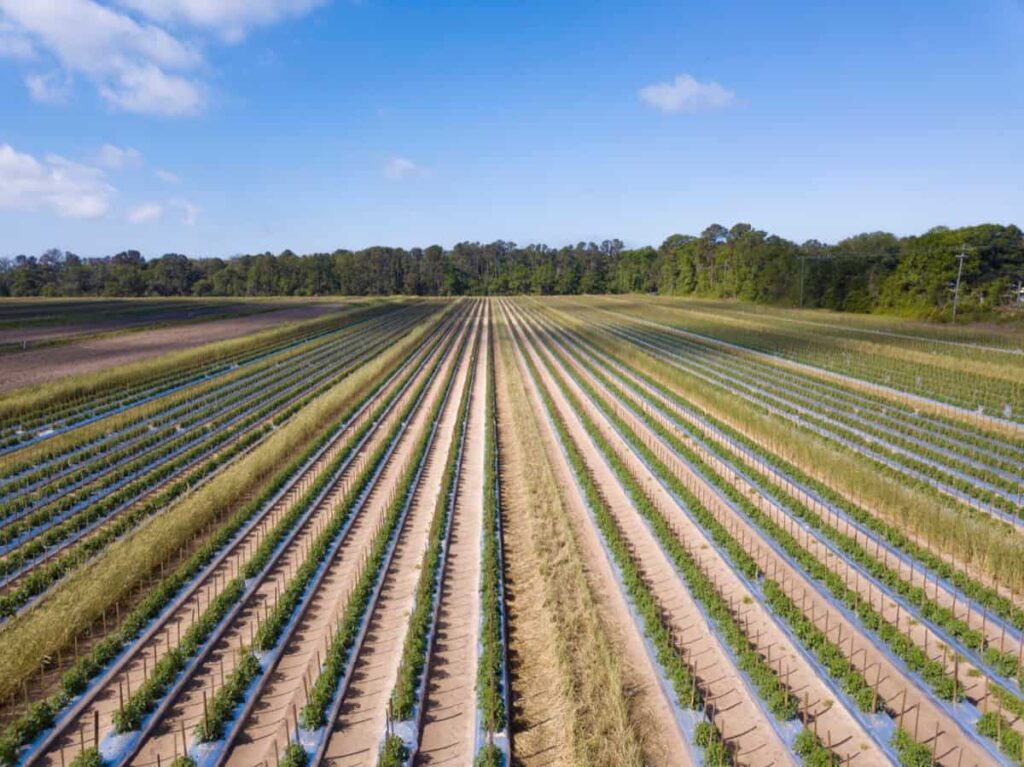
In practically every country, tomatoes are grown outdoors, in greenhouses and net houses. Regarding tomato production, China, India, the USA, Turkey, Egypt, Iran, Italy, Spain, and Brazil are the top producers. After potatoes and onions, it is the third largest vegetable crop in the world. Even after the creation of Telangana, Andhra Pradesh remains the top tomato producer. In terms of Indian produce, Andhra Pradesh accounts for 13.9%. The districts of Kurnool, Chittoor, Visakhapatnam, and Prakasam produce the most tomatoes.
Growing Tomatoes organically in Andhra Pradesh
How the Andhra Pradesh government supports organic farming
The AP promotes organic farming as chemical-free through Paramparagat Krishi Vikas Yojana (PKVY). In addition to organic production and certification, the scheme includes post-harvest management, such as processing and packaging. The government has also initiated a program to provide financial assistance to individual farmers with 20 or more acres of land at 1000/- per acre for three years for Participatory Guarantee System (PGS) certification through the Regional Council or National Programme for Organic Production (NPOP) certification.
For organic inputs such as seeds, fertilizers, pesticides, manure, compost/vermicompost, botanical extracts, etc., farmers are provided financial assistance of Rs 13000/acre / 3 years and Rs 12000/acre / 3 years under MOVCDNER and PKVY schemes. In addition, during the three years, the BPKP provides financial assistance in the form of 5000 rupees/acre for cluster formation, capacity building, continuous handholding from trained personnel, certification, and residue analysis.
In case you missed it: Nutritional Deficiencies in Tomato Crop: How to Fix, Solutions, and Treatment
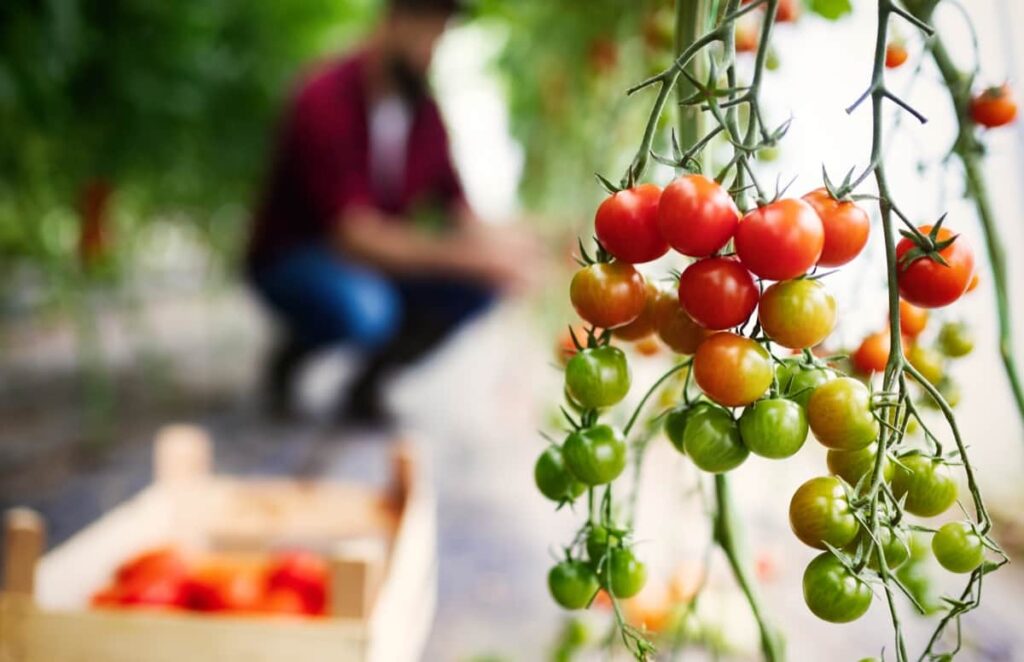
Climate requirements for cultivating Tomato crop
The tomato is a warm-season crop. The best fruit color and quality can be achieved at a temperature range of 21-24°C. Fruit set and development are adversely affected by temperatures over 32°C. The plants cannot tolerate high humidity and frost. It requires a low to medium amount of rainfall. Dark red fruits develop better when the sun is bright at the time of fruit set. Temperatures below 10°C adversely affect plant tissues, slowing physiological activity.
Soil requirements for cultivating Tomato crop
The plant can be grown in various soil types, including sandy loam, clay, black soil, and red soil, with proper drainage. The best results are obtained when the soil is well-drained and has a high organic content. A pH of 7-8.5 is recommended for good growth. Soils with moderate acidity and salinity can be tolerated by it. However, it is best to avoid cultivating highly acidic soils. Clay loam and silt-loam soils are good for heavy yields, whereas light soils are good for early crops.
Nursery bed preparation for Tomato seedlings
Seedlings are raised in nurseries before being transplanted to the field. First, a raised bed measuring 3×0.6m and 10-15 cm high is prepared. The distance between the two beds is about 70 cm, so watering, weeding, etc., can be carried out between them. The beds should have a smooth and well-leveled surface.
Next, spread fine sand and sieved farmyard manure on the seedbed. Raised beds are necessary for heavy soils to prevent water logging. However, flatbeds are best for sowing in sandy soils. Drench the seed bed first with water, followed by Bavistin (15-20 grams/10 liters of water) to prevent damping off.
In case you missed it: Roma Tomato Growing Guide: For Pots, Ground, Raised Beds, and Buckets
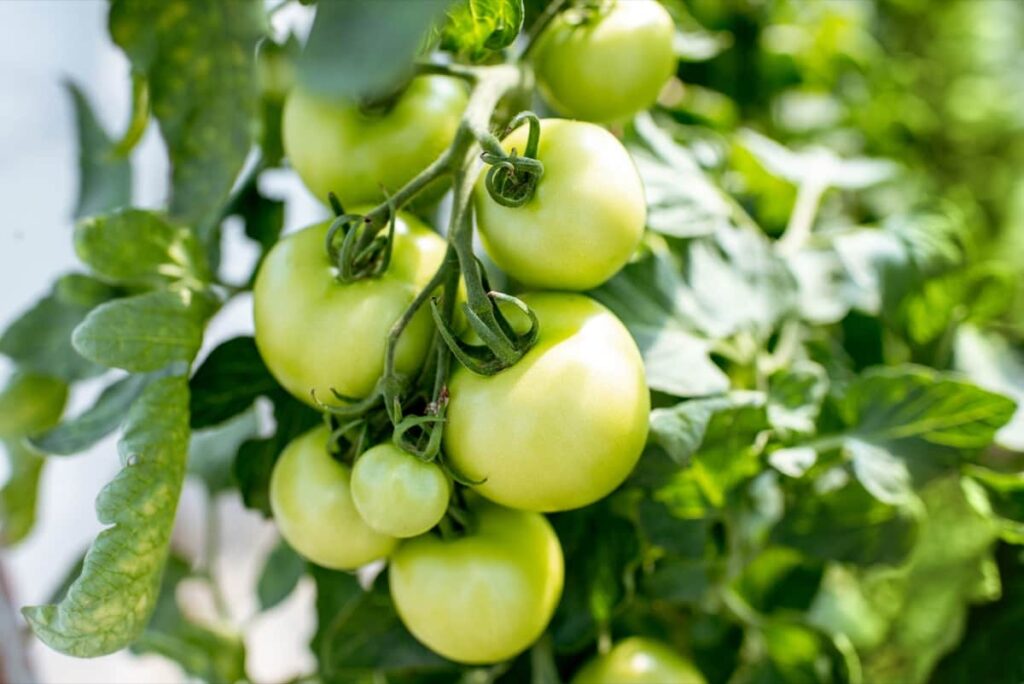
Raising of Tomato seedlings
The seed needed to raise seedlings for cultivating one acre of land is about 100-120 grams. A fungal culture of Trichoderma viride (4 grams per kilogram of seed) or Thiram (2 grams per kilogram of seed) is applied to seeds before sowing to prevent damage caused by damping-off. The seed should be sown thinly in lines 10-15 cm apart. In the spring, seeds are sown at 2-3 cm depth, covered with soil, and lightly watered with a watering can.
For the beds to maintain the necessary temperature and moisture, dry straw, grass, or sugarcane leaves should be used as a cover. Once germination has been completed, water the seeds with a water can. Immediately after germination, dry straw or grass is removed. Water may be withheld slightly during the last week in the nursery to harden the seedlings. Within four days of sowing, seedlings with five to six true leaves are ready to transplant.
Main field preparation and transplanting of Tomato seedlings
For tomato plantation, it required well-pulverized and leveled soil. To bring soil to a fine tilth, plow the land 4-5 times, and then planking is done to make soil level. At the last plowing, add well-decomposed cow dung and Neem cake at 8kg per acre should be applied. Transplantation of tomato is done on a raised bed. For that, prepare raised bed of 80-90cm in width. To destroy harmful soil-borne pathogens, pests, and organisms, soil solarization is carried out.
It can be done by using transparent plastic film as mulch. This sheet absorbs radiation and thus increases soil temperature and kills the pathogen. Tomato seedlings should be transplanted into the field when they are 3 to 4 inches tall, and the nighttime temperature is consistently above 10°C. First, dig holes in the bed 2-3 inches deeper. Plant spacing can range from 30 to 60 inches depending on the mature size.
As a next step, plant only the topmost leaves aboveground, with the seedlings deep in the soil. Although it is a death knell for some plants, this technique improves drought tolerance, root establishment, and wind resistance in tomatoes. Your next step will be to firmly tamp the soil around the seedlings and then water them for the first time.
Irrigation requirements in Tomato cultivation
Depending on soil moisture, apply irrigation every six to seven days during winter and every ten to fifteen days during summer. Cracking occurs when fruits are dried out and then heavily watered. The flowering stage is critical for irrigation. Water stress during this stage can lead to flower drop and adversely affect fruiting and productivity. According to various research, it is found that half-inch irrigation every fortnight causes maximum penetration of roots and thus gives a high yield.
Manure application in Tomato cultivation
Nutrient availability and fertilizer application affect fruit production and quality, so balance fertilizer is applied accordingly. If nitrogen is present in adequate quantities, fruit quality, size, color, and taste will be improved. Additionally, it enhances the acidic flavor. Growth, yield, and quality also require adequate potassium.
In case you missed it: How to Grow Cherry Tomatoes at Home: from Seeds and Tomatoes in Pots, Indoors, and Planting, Care
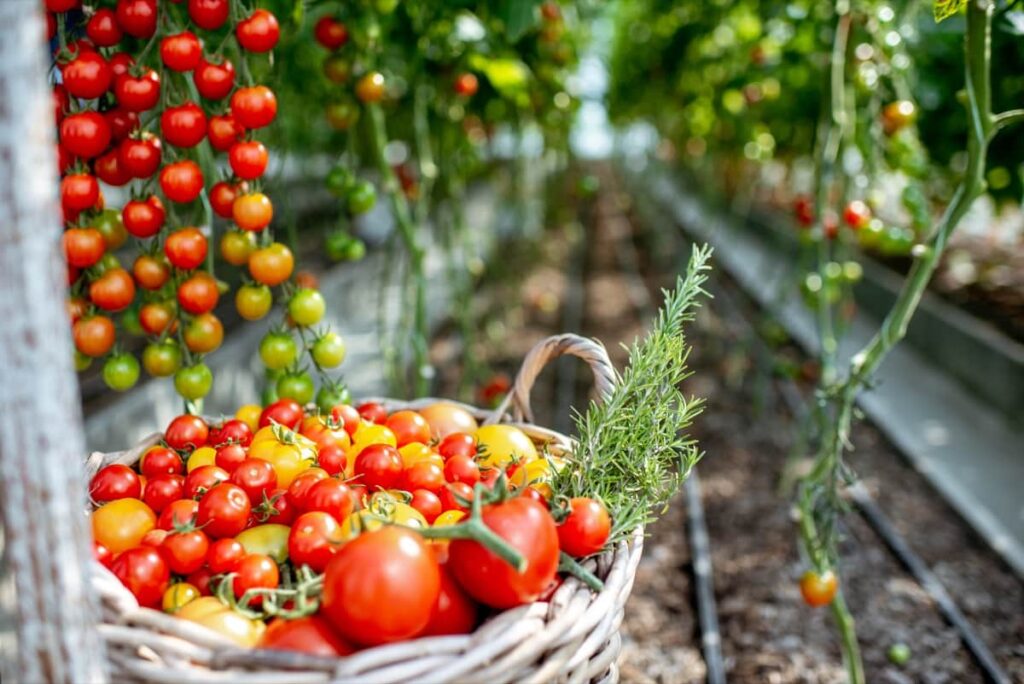
An application of farm yard manure at 8 tons/acre as basal or poultry manure at 2 tons per acre was found to be the best and cost effective organic nutrient management practice for better fruit yield and quality of tomatoes as well as maintaining the soil health. Liquid organic fertilizer made from manure (rabbit and goat manure) and green manure (white lead tree and elephant grass) doses of 20 ml per liter enhanced the fruit yield and vitamin C of organic tomato.
Weed control in Tomato cultivation
Weeds should be kept out of the field during the initial stages of plant growth because they compete with the crop and significantly reduce the yield. The field should be regularly cultivated shallowly to prevent weed growth, facilitate soil aeration, and promote proper root growth. Deep cultivation harms roots and exposes moist soil to the surface, damaging roots.
It is necessary to hoe and earth up the crop twice or three times per year to keep it weed-free. The control of weeds can be achieved by hand weeding 45 days after transplanting. You can control weeds by mulching (black or transparent) with plastic.
Staking Tomato plants
It is essential to stake hybrids because of their tall habit and heaving-bearing nature. Additionally, staking facilitates intercultural operations and maintains fruit quality. It is carried out 2-3 weeks after transplantation. It is possible to stake plants with wooden stakes or by laying overhead wires to which each plant is tied. Plants are attached to two or three wires that are spread parallel to each other in the case of indeterminate types.
Major pests in tomato farming and their organic control
Gram pod borer
Damage symptoms
- Young larva feeds on the leaves for some time and then attacks fruits.
- Internal tissues are eaten severely and completely hollowed out.
Control and management
- Rotate the tomato crop with a nonhost cereal crop, cucurbit, or cruciferous vegetable.
- Conserve predators such as King crow, common mynah, wasp, dragonfly, spider, robber fly, reduviid bug, praying mantis, fire ants, big-eyed bugs, pentatomid bugs, earwigs, ground beetles, rove beetles, etc.
Spider mites
Damage symptoms
- Affected leaves become reddish brown and bronzy
- Severe infestation larvae silken webbing on the leaves
- Leaves wither and dry
- Flower and fruit formation affected
In case you missed it: High Yield Hybrid Tomato Varieties in India: For Winter, Summer, and Rainy Season

Control and management
- Field sanitation, roguing of affected plants
- Plant tall border crops such as maize, sorghum, etc.
- Conserve predators such as predatory mites, staphylinids, ladybird beetles, lacewings, predatory thrips, mirid bugs, predatory flies, etc.
Whitefly
Damage symptoms
- Chlorotic spots
- Yellowing
- Downward curling and drying of leaves.
- Vector of tomato leaf curl disease.
Control and management
- Adult populations can be monitored and suppressed using yellow sticky traps.
- The whitefly parasite, which destroys nymphs and pupae, is one of the natural predators of these pests. In addition, ladybugs and lacewing larvae feed on their eggs.
- You can spray Organic Neem Oil on vegetables, fruit trees, and flower plants to kill eggs, larvae, and adults.
Major diseases in Tomato crop and their organic control
Damping Off
Damage symptoms
- A seedling is killed just before it emerges from the soil in the pre-emergence stage.
- The young radical and plumule have been killed, and the seedlings are completely rotten.
- Post-emergence is characterized by infection of young, juvenile collar tissues at the ground level.
In case you missed it: Vertical Tomato Farming: Modern Way of Getting More Yields in Less Space
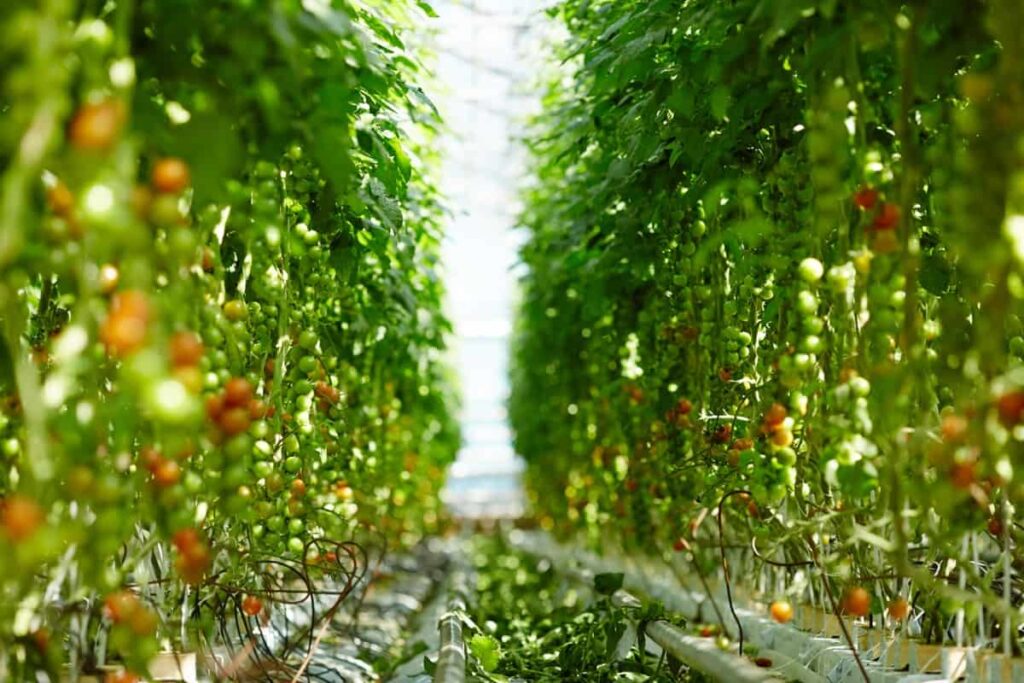
Control and management
- Excessive watering and poorly drained areas of the field should be avoided
- Use raised beds: 15 cm height is better for water drainage, or uses pro-trays for raising seedlings
- Seed treatment with Trichoderma viride 1 % WP at 9 grams/kg of seed.
Leaf curl
Damage symptoms
- Leaf curl disease causes severely stunted plants with downward rolling and crinkled leaves.
- As the leaves emerge, they exhibit a slight yellow coloration; later, they show curling.
- Older leaves become leathery and brittle. As a result, the nodes and internodes are significantly reduced in size.
Control and management
- Field sanitation, roguing of affected plants
- Raise barrier crops-cereals (maize or sorghum) around the field.
- Peppermint can be used as a repellant plant for whitefly.
- Yellow sticky traps or cards at 10/acre may reduce the whiteflies population
Bacterial wilt
Damage symptoms
- Lower leaves may drop before wilting.
- In severe cases, it may invade the cortex and pith and cause yellow-brown discoloration of tissues.
- When cut and immersed in clear water, infected plant parts and a white streak of bacterial ooze are seen coming from the cut ends.
Control and management
- Crop rotations, viz., cowpea-maize-cabbage, okra-cowpea-maize, maize-cowpea-maize, and finger millet- brinjal are reported effective in reducing bacterial wilt.
- Use seedlings from pathogen-free seed beds.
- Restriction of irrigation water flowing from the affected field to the healthy field
- Apply Neem cake at 100 kg/acre.
Harvesting Tomato crop
After transplanting, fruits are ready for picking 60-70 days after they are transplanted, depending on the variety. Fruits are harvested based on the purpose for which they are to be used. Harvesting is divided into the following stages:
- Dark green color: The color changes from dark green to reddish pink on the fruit. During this stage, fruits will be harvested for shipping. Forty-eight hours before shipping, such fruits are sprayed with ethylene. Immature green tomatoes will ripen poorly and have poor quality. Slice the tomato with a sharp knife to determine its maturity. When seeds are cut, the fruit is too immature for harvest and will not ripen.
- Breaker stage: A dim pink color was observed on 1/4 of the fruit. During this stage, the fruits are harvested to ensure their quality. A mature tomato often fetches a higher price than one less mature because it is less prone to damage during transportation.
- Pink stage – Pink color observed on ¾ part of the fruit.
- Reddish pink: Most of the fruit turns a reddish pink, and the fruits are stiff. At this stage, fruits are harvested for local sale.
- Fully riped: A dark red color is present on the fruits, which are fully ripe and soft. Processing is done with such fruits.
In case you missed it: Tomato Farming Guide for Beginners: Production Techniques, Process, and Steps
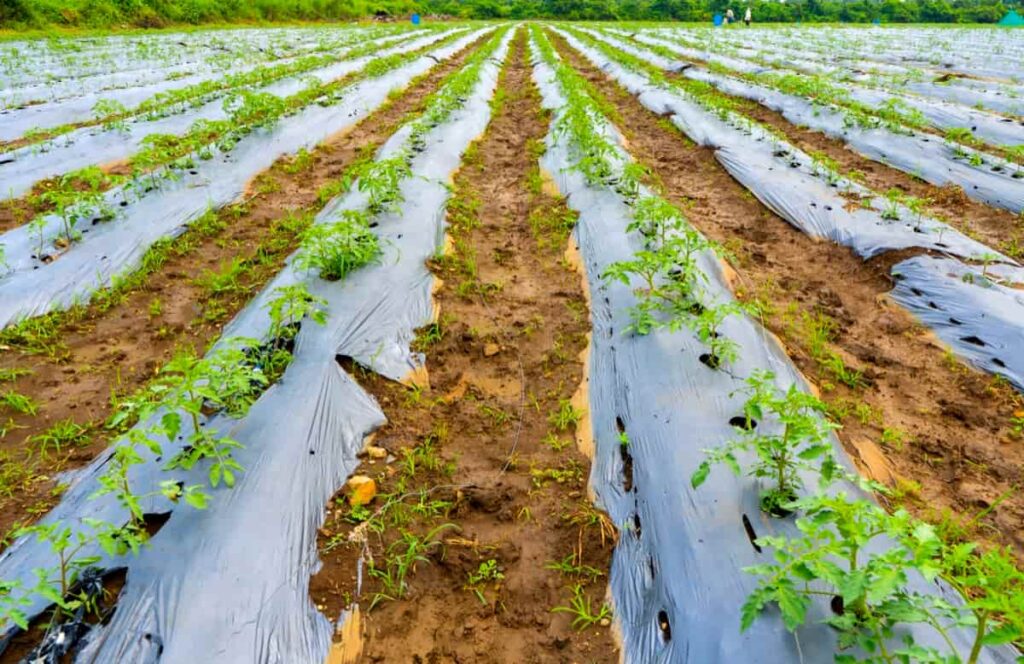
Fruits are typically harvested early in the morning or late in the evening. Harvesting fruits involves twisting the hand to separate them from the stems. It is best to store harvested fruits in baskets or crates and in the shade after harvesting. It takes four days for all the fruits to mature, so they are harvested at intervals of 4 days. A crop will typically have seven to eleven harvests over its lifetime.
Conclusion
There is no doubt that tomato cultivation is one of the most profitable agriculture businesses. A four-time harvest is an excellent option for those who want to harvest a commercial crop every four months. The tomato is cultivated throughout the year in almost all seasons, but a farmer can get the best yields if the crop is planted in winter or spring.
- How to Raise Pigs in Your Own Backyard: A Comprehensive Guide
- Budget Friendly Sheep Shed Ideas: Cheap and Low-Cost Tips
- How Much Do Cattle Farmers Make: Revenue Streams in Cattle Farming
- Management Pests and Diseases in Your Cotton Field
- Sheep Farming Business Plan for Beginners
- Aquaponic Farming at Home: A Step-By-Step Guide
- Profitable Village Farming Business Ideas in 2024
- High-Yield Aquaculture: Fast-Growing Fish for Farming
- Effective Fish Pond Construction Techniques for Beginners
- Irrigation and Water Management in Pineapple Farming
- Blossom to Harvest: Mastering Flowering and Pollination in Papaya Farming
- Pig Fattening Essentials: From Selection to Sale for Beginners
- Raising Wagyu Cattle: A Complete Guide for Premium Beef Production
- Soil Types and Their Water Holding Capacity
- Optimizing Irrigation Schedules for Coconut Groves for Enhanced Yield
- Espresso Your Garden: Coffee Grounds for Healthier Acid-Loving Plants
- The Best Soil Mix for Snake Plants: How to Mix Your Own Snake Plant Soil
- Green Thumb Success: Expert Tips for Cultivating Greenhouse Beans All Year Round
- Bloom All Year Round: The Ultimate Guide to Indoor Hyacinth Care
- Eco-Friendly Gardening: How to Make Liquid Fertilizer from Kitchen Waste
- Ultimate Guide to Grow Anise in Pots: Explore Seed Propagation to Harvesting
- Guide to Raising Chester White Pigs: Discover Breed Facts to Growth Management
- Mastering the Elegance: The Ultimate Guide to Weeping Cherry Tree Care, Planting, and Maintenance
- Ultimate Guide to Planting Garlic in Grow Bags: Growing Strategies for Beginners
- How to Fix Spider Plant Leaf-Related Problems: Natural and Organic Remedies
- 10 Reasons Why Your Tulsi Plant is Shedding Leaves: Home Remedies and Solutions
- Optimizing Growth and Yield: The Advantages of Palm Bunch Ash Fertilizer
- Utilizing Neem Oil Extract as a Natural Pesticide for Hydrangea
- From Soil to Harvest: Various Ways in Which Farmers Can Use AI Tools
- Steps to Encourage and Induce Citrus Flowers: A Comprehensive Guide
- How to Fix Snake Plant Leaf-Related Issues: Natural and Organic Remedies
- Transform Your Garden into a Fragrant Oasis with Raat Ki Rani (Night Blooming Jasmine)
- Discover the Ideal Chicken Breeds for Philippine Farms
- How to Create a Poultry Egg Farm Business Plan for Profits
- Grow Lemon Cucumbers Like a Pro: Insider Techniques for Bountiful Yields
- Ultimate Guide to Caring for Your Pink Princess Philodendron: Tips for Thriving Variegation
